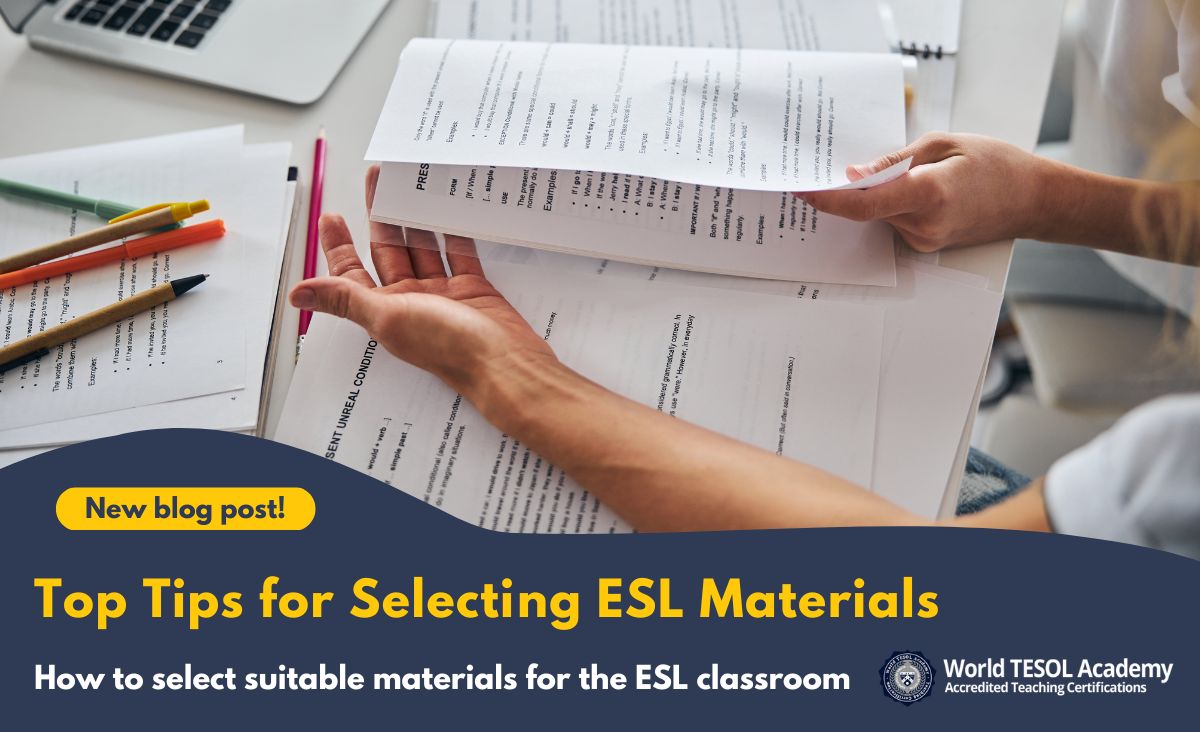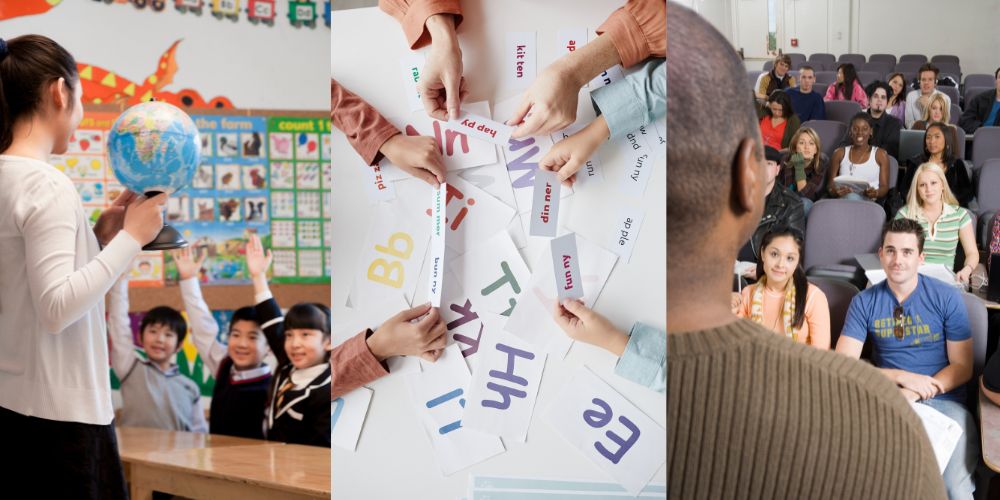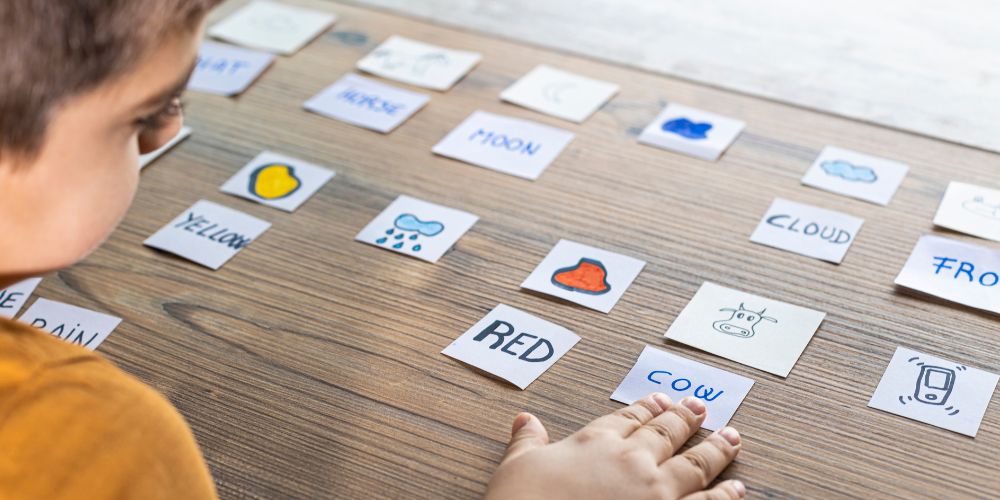
Top Tips for Selecting ESL Materials
In today’s diverse ESL classrooms, teachers face the important challenge of selecting suitable teaching materials that cater to the learning needs, experiences, and goals of their students.
The key to navigating this challenge lies in the careful evaluation and selection of materials that not only align with the learning objectives of your lessons, but also match your students’ varied proficiency levels, expectations, and learning needs. While the process of selecting suitable teaching materials can seem daunting at first, there are a few practical guidelines that you can follow to simplify the process.
We’ve compiled a few handy questions that you can ask yourself when evaluating the suitability of your ESL teaching materials. Let’s dive in!

Does it align with the learning objectives?
One of the cornerstones of conducting effective ESL lessons is the careful selection of teaching materials. Whether it’s introducing new vocabulary, practicing grammar, or developing communicative skills, you should always ensure that the resources you choose serve a clear purpose, and that they align with the learning objectives of the lesson.
The significance of this alignment cannot be overstated. When the materials directly support the learning objectives, every lesson becomes a targeted effort toward achieving specific learning outcomes. Students are also more likely to take in and digest new concepts, and retain knowledge more effectively if the materials closely align with the carefully planned learning objectives of the class and the overall curriculum.
Example: If the learning objective of a lesson is to teach students how to order food at a restaurant, you can choose materials that align well with activities where your students would practice ordering food, e.g. restaurant menus for role-playing.
Or if the objective is to teach students how to write an email in English, you can choose materials such as sample emails and template guides that demonstrate the techniques and formatting used when writing emails.

Is it relevant to the students?
An effective way of significantly enhancing your students’ interest and engagement during your lessons is to ensure that the materials are relevant to their interests and experiences. By taking your students’ interests, cultures, and experiences into consideration, you can transform lessons from abstract concepts into meaningful and engaging learning experiences.
This is an effective way of personalizing the learning experience for each student, as relevant materials can help students connect with the language, motivate them to learn, and increase their knowledge retention. Moreover, when students find personal significance in the material, it can lead to increased curiosity and a desire to explore the language further, laying the groundwork for lifelong learning.
Example: If your students are interested in sports, you can choose materials such as news articles, interviews, or video clips that discuss sports-related topics. Or if your students are interested in technology, selecting articles or video clips about the latest tech trends can make lessons more engaging.

Is the material authentic?
The use of authentic materials is important as it exposes students to the English language as it’s naturally used and encountered in the real world. This includes exposing them to idioms, colloquialisms, different accents, cultural references, etc., which are essential aspects of learning how a language operates in various real-life contexts and developing fluency.
Choosing authentic materials can also make learning more interesting and engaging, as they often involve current and topical content.
Example: You can use movie scenes or a TV show clip to teach students how to use idiomatic expressions or colloquial language. You can also use audio clips of dialogues that show how the language is used in various contexts, from casual conversations to more formal situations.
To provide more of challenge, you can include different native accents and dialects. This can help students develop a wider understanding of the real-life of use the language.

Is it age and level-appropriate?
Navigating the diverse landscape of the ESL classroom means recognising and addressing the unique needs of your learners. This task includes the selection of appropriate materials that must be carefully tailored to match not only the cognitive and developmental stages of the students but also their language proficiency levels.
The importance of choosing age and level-appropriate materials lies in their ability to support the creation of an optimal learning environment. Materials that are too challenging can lead to frustration and disengagement, while those that are too simple might result in boredom and a lack of progress.
By finding the sweet spot, you can keep your students motivated and ensure that their learning experiences are both productive and enjoyable. In addition, appropriately leveled materials can also help build confidence and self-efficacy among your students, which are crucial components of effective language acquisition.
Example: Using flashcards, images, or realia with your younger or beginner students can help make the learning more fun and engaging. For your older students or more advanced students, you can choose materials that provide them with the opportunity to analyse the language and develop a deeper understanding, such as news articles, novels, or academic papers.

Is the material inclusive?
As ESL teachers often teach in multicultural settings, it’s important to realise that inclusivity extends beyond creating a friendly and welcoming atmosphere in the classroom. The importance of promoting inclusivity through your teaching materials lies in the potential to create a supportive learning environment that reflects and celebrates the diversity of your students and the world at large.
By selecting inclusive materials, your students have the opportunity to feel represented and valued which can significantly help enhance their self-esteem and allow them to connect with the materials more profoundly. It’s also a great way to foster empathy and cultural awareness which is valuable when preparing your students for stepping into the world as global citizens.
Example: You can use materials that feature stories or characters from a variety of cultures, backgrounds, and life experiences. Selecting materials that include examples and texts that embrace diversity and avoid stereotypes can help ensure that every student feels included and can see themselves represented in the curriculum.

Which learning styles does it cover?
Recognising and accommodating the diverse learning styles that ESL teachers encounter in the classroom is essential for conducting effective and inclusive lessons. Every student absorbs and processes information differently, which can significantly influence their language learning journey.
By selecting materials that cater to a broad spectrum of learning preferences, you are able to create a more engaging and supportive learning environment that can help enhance each student’s learning experience. When students engage with materials that align with their preferred learning styles, they are more likely to stay motivated, engage with the content more deeply, retain information longer, and make the overall learning experience more enjoyable.
Example: Preparing visual materials such as charts, infographics, and images can help visual learners grasp concepts more effectively. Similarily, auditory learners can benefit from including auditory materials such as sound clips, oral storytelling, songs, etc. which can help them absorb the rhythm, intonation, and nuances of the language more naturally.
It can also be good to remember that many materials offer sensory rich experiences that cater to multiple learning styles, e.g. videos which can be effective for both visual and auditory learners.

Is it adaptable to teach other language skills?
The ability to adapt teaching materials to various contexts and objectives is invaluable for ESL teachers. Flexible materials can be repurposed to cover different language skills, topics, or learning needs, making them powerful tools in the hands of a creative teacher.
This multifunctionality not only allows you to streamline lesson planning but can also help your students make connections between different aspects of the language which in turn can provide them with a more comprehensive understanding. It’s also an effective way to avoid overwhelming both your students and yourself with an excess of resources.
Example: A reading passage about holiday traditions that is selected for practicing reading comprehension, can also be used to teach related holiday vocabulary, or various grammar structures. The reading passage can then be adapted into a writing exercise where the students compare different cultural holiday traditions using the new vocabulary and grammar structures they’ve learned.
Conclusion
Carefully selecting appropriate materials for your ESL lessons is crucial for fostering an engaging and effective learning environment for your students. As you prepare your materials, take some time to reflect on the essential questions we’ve discussed in this article: “Do the materials align with lesson objectives?“, “Are they relevant, authentic, and age-appropriate?“, “Do they promote inclusivity and cater to various learning styles?“, and “Are they adaptable for teaching different language skills?“.
Aiming for a “yes!” to all these questions is a great goal, but remember, finding the perfect material for every learning need might not always be realistically possible. Instead, keep an eye on how well your students respond to the materials and be ready to make changes if needed. Adopting a flexible approach will allow you to tailor effective ESL lessons that can help support your students on their language-learning journey.
Getting your TESOL/TEFL certificate: Selecting suitable materials is an important part of the lesson planning process if you wish to create effective learning experiences for your students.
In our 120-hour TESOL/TEFL course, you’ll not only learn how to plan ESL lessons and activities using suitable materials, but you’ll also learn a variety of other powerful techniques and strategies that will allow you to tailor effective learning experiences for your students.
If you haven’t enrolled in the course you can do so here:
.




Leave A Comment